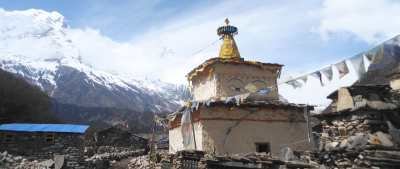Important Information
Region
Manaslu Region Treks
Duration
16 Days
Max Altitude 5093m
Best Season March - November
Activity Per Day
5-6 hrs
Grade
Level 3
Group Size
2 - 12 people
Transportation Jeep
Tsum Valley Trek is a hidden treasure of Gorkha district of Nepal, situated in the northern Gorkha between the majestic scenery of the Boudha Himal and Himal Chuli to the west, Ganesh Himal to the south, and Sringi Himal to the North with the elevation varies from 1905m in Lhokpa to over 5093m at Ngala Dhojhyang pass on the Tibetian border. The Tsum valley was restricted until the year 2007. Local people are known as Tsumpa and they have their own unique culture, tradition, & dialect mostly related to the Tibetan language. The Tsum valley comprises many religious monasteries such as Dhephyudonma Gompa, Rachen Gompa, and Mu Gompa. In summer they celebrate festivals like Dhacyhang (Archery), Saka Dawa (literally it is the fourth month of the Tibetan calendar, a month Honoring the Buddha’s Life), and Fanning (Picnic). The fascinating landscapes of this wonderful valley will make the imaginations of trekkers beyond expectations.
The trials are decorated with artistic Chortens and lined with Mani walls made of thousands of stone slabs carved with drawings of deities and inscribed with prayers. The circuit traverses across Tsum Valley, the Manaslu area in Nepal, and the southern parts of Tibet. The Buddhist saints Milarepa and Guru Rinpoche are believed to have meditated in the caves of these mountains due to their remoteness and inaccessibility. Even though this area is remote the landscape is amazing.
Tsum Valley has a long history of Buddhism. The famous KyimoLung, a pilgrimage circuit in the central Trans-Himalaya, is well known for its centers of learning and meditation. This sacred valley and its people have been bypassed through mainstream development for centuries where still we can still visit some Buddhist pilgrimage sites.
Himalayan Wander Walkers have organized this trek many times and sent a guide who speaks both English and Tibetan fluently. This trek begins from Arughat in the Gorkha district, which is easily accessible from Kathmandu. We also offer a Manaslu circuit trek with Tsum Valley. Furthermore, please don’t hesitate to contact us.
“Explore the secret Tibetan Buddhist isolated Himalayan Valley through the off-beaten route which provides spectacular views of the majestic mountains and cultural bliss of Tsumpa people.”
Highlights of Tsum Valley Trek
- The scenic drive from Kathmandu to Arughat
- Exploration of the Tibetan culture and lifestyle
- Waterfalls, rivers, and caves along the way
- A comparatively easy trek with no fear of altitude sickness
- Wildlife animals like blue sheep and Himalayan Thar
- Many Buddhist monasteries
- Prayer flags and Mani walls along the route
- Stunning views of mountains like Ganesh Himal and Himal Chuli
- Beautiful pine, juniper, and Rhododendron forests.
If you are looking for a different itinerary than the itinerary here, please Customize Your Trip.
Include
Transport from Kathmandu to Macha Khola and Return by Private 4*4 WD vehicle.
Tea House/lodge accommodation during the trek.
Three-night Accommodation with breakfast in 3* hotel in Kathmandu.
All Standard Meals (Breakfast, Lunch, and Dinner) during the Trek.
Official Himalayan wander walkers (Government registered and licensed) Expert Guide, 1 Assistant Guide for 12 or Above
Trekkers with accompanying porters (generally, 1 porter per 2 trekkers) to assist with carrying gear during the trek. (We cover the porters’ meals, lodging, salary, transport, insurance, equipment, and other essentials.)
Tsum Valley special permit and Conservation Area Permit
Arrangement of emergency evacuation service (should have insurance for emergency evacuation and will be paid by your travel insurance company)
Farewell Dinner in Kathmandu before your international departure
Exclude
International flight airfare
Excess baggage charges
Meals in Kathmandu
Extra night accommodation in Kathmandu due to early arrival, late departure, early return from trekking.
Personal expenses such as shopping, snacks, bar bills, bottle or boiled water, shower, Wi-Fi, laundry, telephone call, battery re-charge fee extra porters, etc.
Personal clothing and gear
Travel insurance
Tips for guide and porters
Additional costs or delays caused by out of management control, for example, landscape, weather condition, itinerary modification due to safety concerns, illness, change of government policies, strikes, etc
Important Information
CHECKLISTS
- Valid passport (valid for six months from the date of your trip)
- One other picture ID, such as driver’s license (in case of emergency and for use as a substitute of passport or in case of loss of your passport) Photocopy of passport page to carry in a wallet
- Air tickets (Make a copy of flight tickets which may be helpful, in case of loss)
- Visa Clearance (Make a copy of visa clearance which may be helpful, in case of emergencies)
- MasterCard, Visa Credit, and Debit Cards are accepted in Nepal. However, traveler's cheques and some cash are highly recommended.
- Mobile (if your cell phone is from CINGULAR USA or ATNT (USA) operators then your cell phone will work in Nepal.)
Guiding, Food, and Lodging
In Nepal, all trekking supplies - Teahouse trekking means staying and eating in local lodges. We stay in single rooms where possible, but often you will have to share. The rooms are basic, normally just a bed with a pillow, blankets. A few have electric lights and all have a spacious dining room-lounge. We eat at teahouses and, although the food is usually plentiful and delicious, the menu is not extensive. They offer a variety of potatoes, rice and noodle dishes, as well as soup and seasonal vegetables. Beers and local spirits are often available, but that will be at your own cost. A variety of cereals, bread, and egg dishes are generally available for breakfast. There are also snacks available such as basic biscuits, chocolate, and soft drinks and in some areas, you will find fresh fruit in season. It is normal to meet your porter in the teahouse where you will stay overnight. So, pack your necessary things in your own day pack.
DRESS CODE FOR VISITING MONASTERIES, AND TEMPLES IN NEPAL
- Shirt (either half or full sleeve)
- Full pants/long skirts
- Any type of shoes with socks
- No Hats, No Umbrella, No Slippers, No t-shirts, No short skirt, and No half-pants
- Photographs allowed in the courtyard only.
Note regarding itineraries
Although we generally adhere to the schedule, the itinerary is subject to change for numerous reasons beyond our control, including weather and terrain conditions, suitable campsite availability, and the group's general fitness level. It is important to understand that our trek is logistically complex and it is not unusual that adjustments be made. Our guide will orient you each evening to the following day's plan; their good judgment is the key to the long history of successful treks that Himalayan Wander Walkers has led till now. Please remember that our ability to make adjustments as needed helps to ensure that your trek is successful.
Frequently Asked Question
Yes, you can customize the Tsum Valley Trek. Depending on your preferences, we can adjust the itinerary to suit your needs, such as shortening or lengthening the trek or adding extra days for rest. Just let us know your preferences: “Customize Your Trip."
The best times to trek in Tsum Valley are during the spring (March to May) and autumn (September to November) seasons when the weather is clear and temperatures are mild. Read more about the best season for the Tsum Valley trek.
The trek is considered moderate to challenging. It involves high altitudes, long trekking hours, and some steep ascents, but it is accessible for experienced trekkers with proper acclimatization.
Yes, you need two permits: the Manaslu Conservation Area Permit (MCAP) and the Tsum Valley Restricted Area Permit. Both can be obtained in Kathmandu through trekking agencies. Read more about the trekking permit and its cost for Tsum Valley.
The highest point on the Tsum Valley Trek is the Mu Gumba at around 3,700 meters (12,139 feet), but trekkers typically go up to 3,600 meters (11,811 feet) for a safe experience.
Accommodation is basic teahouses or lodges along the trail. Rooms are simple, and meals are traditional Nepali or Tibetan-style dishes like dal bhat and momo. Expect minimal amenities but warm hospitality.
Yes, it is mandatory to hire a guide since the Tsum Valley is a restricted area. A guide is also necessary for safety, navigation, and carrying gear, especially due to the area's remoteness. A guide will also enhance your experience by sharing insights into the local culture and environment. Read more about guides and porters in Tsum Valley.
You do not need any special gear for Tsum Valley, like the one for peak climbing or mountaineering, but surely need proper sturdy trekking shoes, warm clothes, a sleeping bag, water bottles, sunscreen, a hat, energy bars, and a small first-aid kit. Be sure to pack light but adequately for the weather conditions and trek duration. For more details regarding trekking gear and equipment, read our Trekking Gears blog.
| {{type.min}} - {{type.max}} Pax {{type.name}} - {{type.desc}} | {{type.display_price}} per people |
Extra prices:
Let us help you decide Inquiry
You might also like

- 15 days
- Manaslu Region Treks
Manaslu Circuit Trek
Explore the sensational view of Nubri Mountains including Mount Manaslu (8th highest mountain in the world with 8,156m), Tibetan immigrant culture, and experience the dramatic Larke Pass of 5,100 meters. Manaslu Circuit Trekking, one of the best treks in Nepal regarded by many trekkers....

